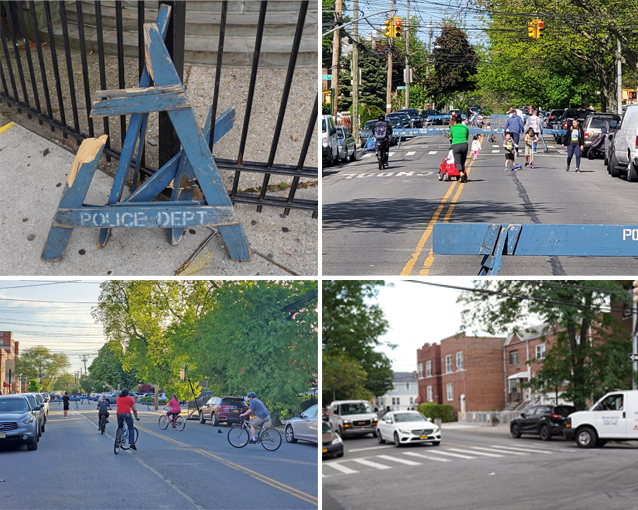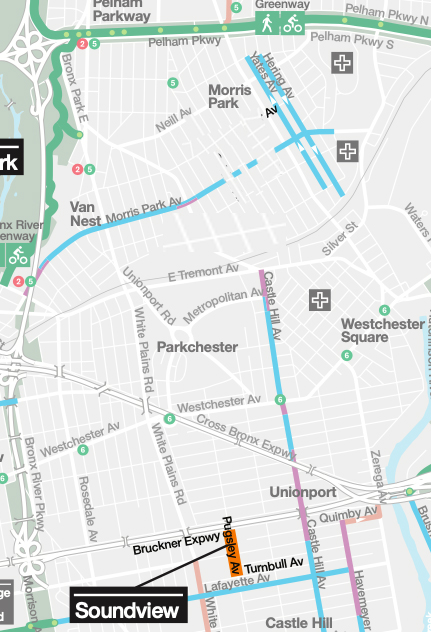To the barricades — um, what barricades?
The car culture of the northeast Bronx won a quiet victory over the craven de Blasio administration this week as city workers packed up their open streets sawhorses and allowed drivers to reclaim Rhinelander Avenue, which had been opened to provide Morris Park residents more space for socially responsible recreation.
The victory for drivers was a loss for a community with far too little open space. It came because the de Blasio administration caved in to a demand from Bronx Community Board 11 — with which it has long tangled over creating safer streets for all road users —to close the street.
The barricades were removed on Wednesday night.
"I'm certainly going to miss having the open street," said resident Michael Kaess, who was on hand as NYPD workers loaded the blue sawhorses onto a truck, never to return. "Just stepping outside of the house and seeing folks enjoying themselves felt rewarding. It's really disappointing that the community board formally asked to have it removed, when it was clear at that point that it was well-utilized and self-sufficient, with neighbors helping maintain it.

"The families I saw out there every day didn't have a voice in this decision," he added. "Rhinelander Avenue is better as an open street than as a shortcut for drivers."
The closure of the open street — which was created due to an emergency public health crisis — is a cautionary tale. Under pressure from residents to create more space so people could get outdoors yet still socially distance, the de Blasio administration announced in May that it would create up to 100 miles of such open streets. A half-mile stretch of Rhinelander Avenue between Williamsbridge and Bronxdale avenues was part of an original tranche of streets announced in May.
Almost immediately, it came under attack from Council Member Mark Gjonaj, who demanded it be removed so that drivers could have full access to every road, all the time. Gjonaj drove to the open street and collected petition signatures from area residents, even as other residents were enjoying the open space. His office said the petitions were turned over to the community board an "no further actions were taken."
Nonetheless, within a week, the city cut the original 10-block stretch to four, or just .19 miles. By June 30, that was reduced to zero.

The Department of Transportation has added two open streets within Community Board 11 — .2 miles of Waring Avenue and .11 miles of Yates Avenue — but both are far north of Morris Park, in an entirely different neighborhood.
Kaess covered the CB11 meeting in late May, where it was clear that board members cared only about the convenience of drivers, who have many other roads in the neighborhood (see map — Rhinelander Avenue is between Neill and Morris Park avenues).
It's not the first time Gjonaj and his appointees on Community Board 11 have quarreled with the city on a road safety plan. Last year, business owners along Morris Park Avenue sued the city, arguing that the DOT did not have the legal right to remove one lane in each direction of the four-lane speedway as part of a road diet plan intended to slow down drivers — a road design that had been used, successfully, in many neighborhoods across the city.
A judge later ruled in the city's favor.
But this time, the de Blasio administration would rather switch than fight.
"We are constantly evaluating every new program in consultation with city agencies, elected officials, and constituents to find and implement best practices," a DOT spokesperson said.
The agency declined to answer the following questions:
1. Did Gjonaj specifically ask the DOT to close the Rhinelander open street?2. Did the DOT create a new open street in the area for residents? [This answer appears to be "no," since the DOT website does not list any new open street in Morris Park.]3. What are the locations of other open streets in the city that were either truncated or entirely removed since its (or their) initial creation?
Not every lawmaker, or would-be lawmaker, is trying to strangle the open streets initiative, however. Zohran Mamdani, currently the leading vote-getter in an Assembly race in Queens, recently emailed his supporters asking them to help make a stretch of 31st Avenue into a thriving open street.
On a Google doc titled "31st Ave Open Streets Collective," Mamdani asked his supporters to volunteer to put up, take down, and keep watch over barricades that would open the avenue from 31st to 36th streets in Astoria. Mamdani, who's waiting for the results of write-in votes for his primary challenge to Assembly Member Aravella Simotas, hopes to "build a more equal, inclusive, and engaged Astoria," he said in the email blast.
But Gjonaj is likely responding to his constituents' and their love of their cars. In a town hall meeting on Wednesday, callers complained of alleged transgressions against drivers. One woman named Edith, for example, complained that the city's open restaurant initiative, which allows restaurants to take over curbside space for outdoor dining, has made it harder for her to find a place to store her vehicle.
Indeed, at the town hall, Gjonaj said he didn't personally have a problem with the open street.
"I don't pick and choose — I did the will of the people," he said.
But he declined to answer Streetsblog's question: "Will you support the creation of new open space in Morris Park now that the neighborhood has none?"
— with Dave Colon






